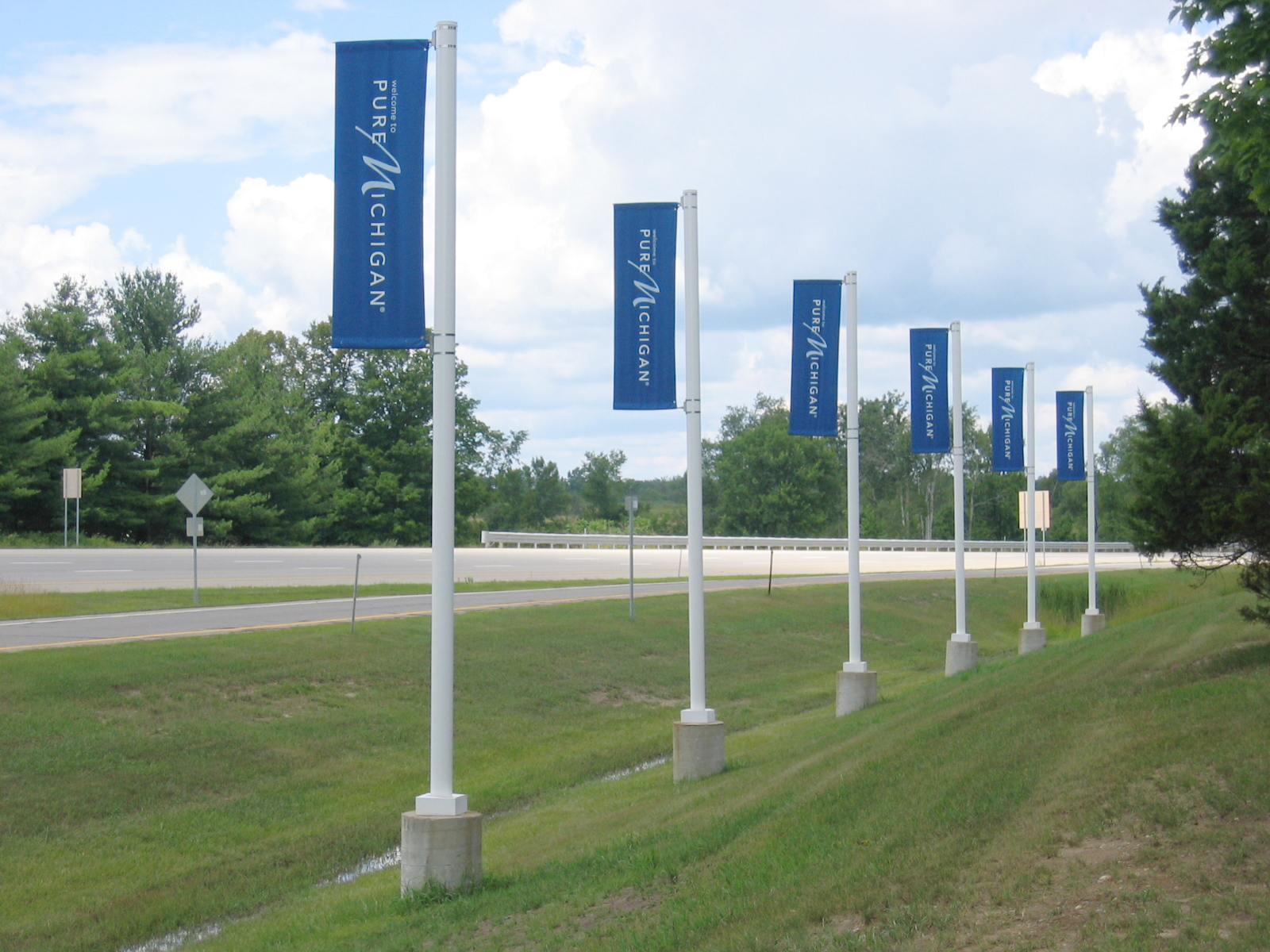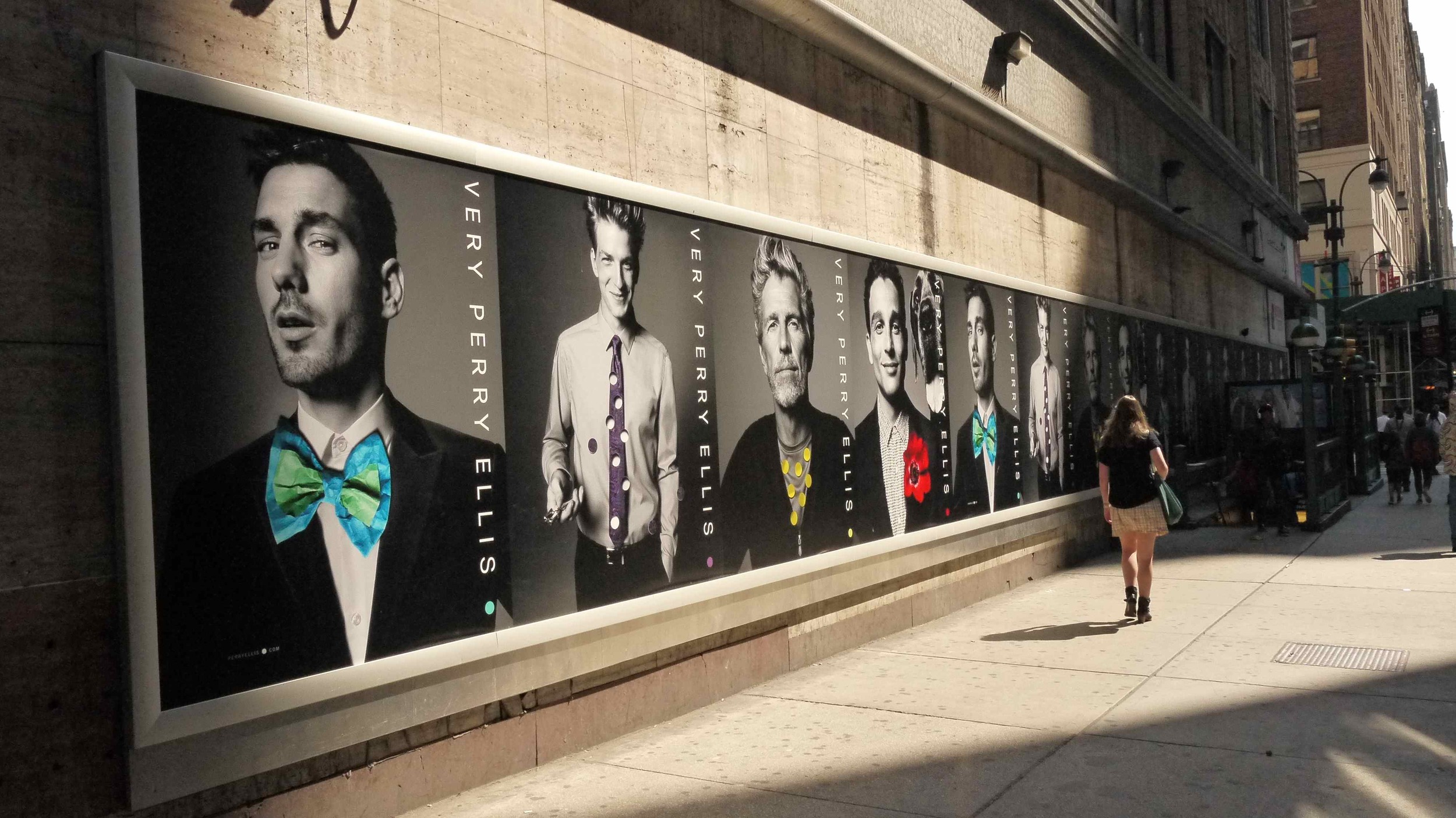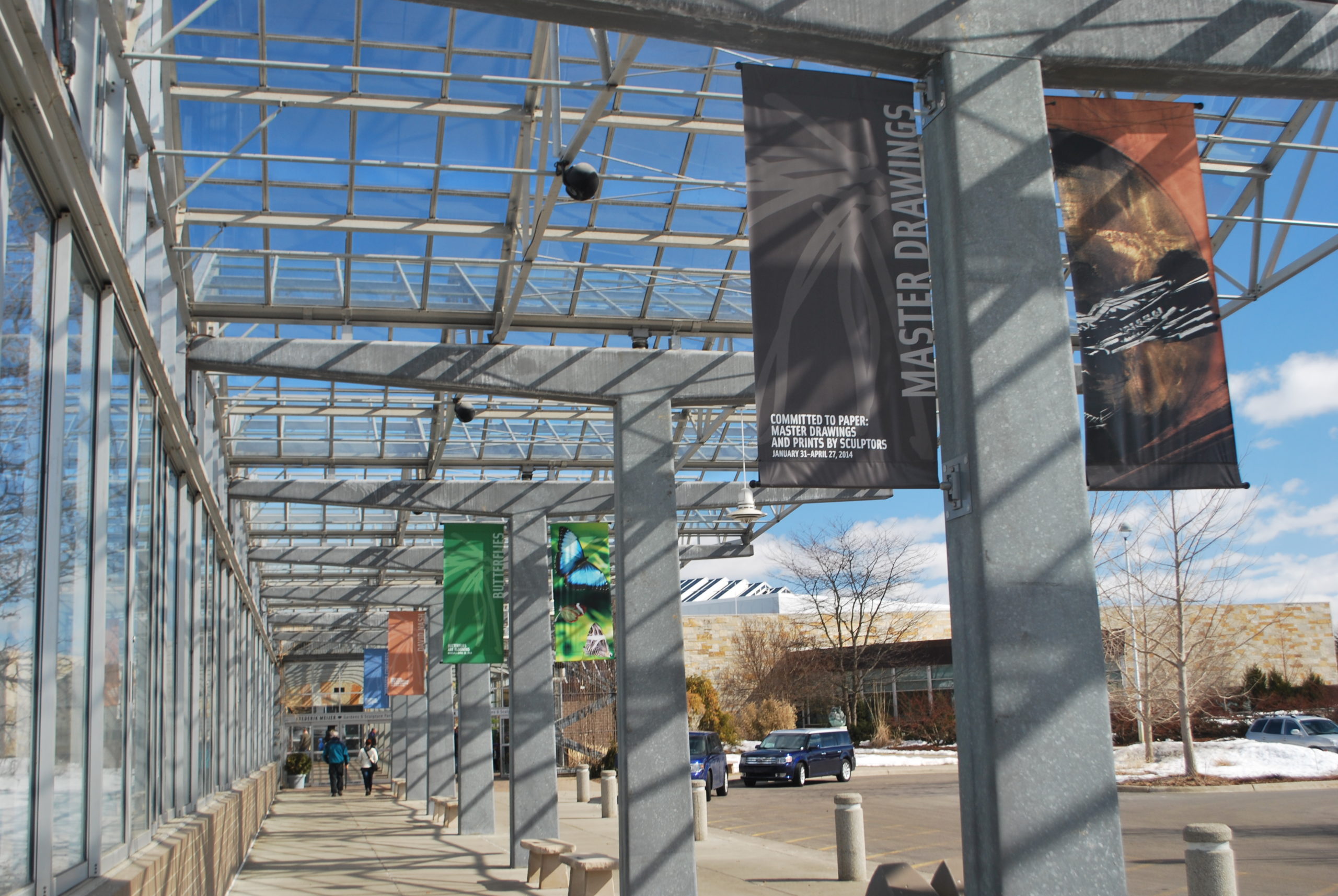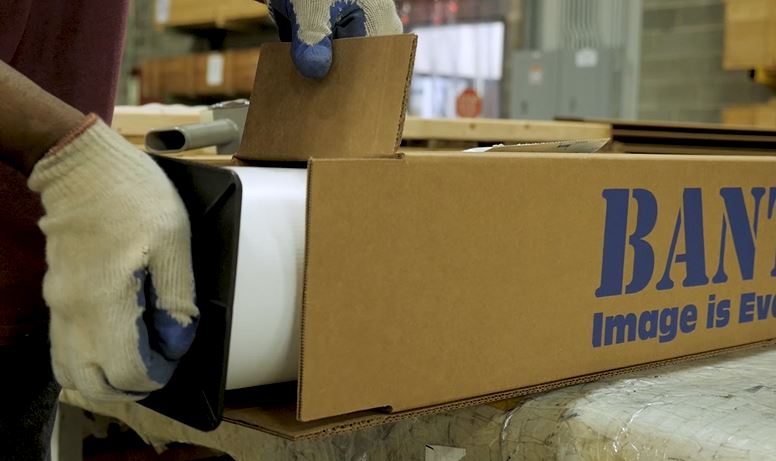Banner Materials: Still Made of the Right Stuff
Improved materials help keep banners booming in their many forms.
Standing the test of time, banners are still one of the most effective ways to reach a targeted audience with a significant advertising message for both indoor and outdoor signage projects. Over the years, the developments of more flexible vinyl and fabric materials as well as the emergence of Silicone Edge Graphics (SEG) applications have injected new life into the category and banners continue to remain a sign industry staple.
Banners Booming
Vaiva Babkauskaite, senior sales executive at Alpina Manufacturing, headquartered in Chicago, says they are currently selling a lot of framing systems for the hot banner market. “The market seems to be booming-we are selling both large and small frames, meaning that the need for various sizes and applications is out there.”
She adds that right now they are seeing most banners being produced with raw edges, but some customers do show an interest in framing systems for banners done with grommets. “I believe some printers increase their cost to print on vinyl and to insert grommets, hence the raw-edge printing popularity. The fact that vinyl is cheap to print on drives the category’s popularity across the board for various applications-indoor and outdoor, small or large.”
Babkauskaite reports that clients are still looking for tighter turnaround times and tighter margins. “Every job we do always depends on the pricing and turnaround time. Customers are more conscious about what they are spending now with so many media options available to them. The plethora of choices allows price comparisons and quality comparisons between suppliers when looking for a specific product.”
Speed is the Key
Roger Lepley, AIA, president of Consort Display Group, Kalamazoo, Michigan, also sees a boom in banner sales. “The banner market in general has never been better. Digital printing has made them quick, easy and inexpensive to produce. For interior applications, it’s best to use materials such as poly film; Tyvek and so on are simple and, of course, strong enough. For the exterior market, depending on size of banner and the ‘look’ sought, we recommend screen-printed marine acrylic (Sunbrella type of textiles) and heavy-weight vinyl such as 18 ounce scrim vinyl from Piedmont or Bantex.”
He adds that it appears that the most common thread in the industry is speed. “Customers don’t make up their mind until they need it now. Banner printing companies that can’t produce good quality quickly, often miss out on a lot of opportunities. Speed is the key. There is good quality printing machinery out there and the presses get better all the time. However, it’s the artwork, production and finishing capability that can make or break many deals in spite of how advanced the printers are.”
Tighter Margins
Ana Armendariz, graphic arts manager at Arlon Graphics, Placentia, California, says that the banner market is fairly commoditized with customers able to use products readily available to suit their needs and price points.
“The reason banner material is so competitive is because of cheap products flooding the market from overseas,” she says. “Customers need material quickly and cheaply. Suppliers/distributors need to offer ways to differentiate products to appeal to the customer, without driving price and margins down even further.”
Armendariz reports there is a growing trend with more environmentally friendly material for non-PVC type banner sign applications. “As regulatory codes get stricter, fabric banners for interior signage are becoming more prominent in the market. Fabric banners can be used in front-lit and backlit applications, across a wide variety of print systems, including dye sublimation.”
She explains that most of their customers are using banner for a wide variety of applications, from billboards to mall advertisements, hanging signage, light post displays, retail signage, construction barricades and many more. “Most are short-term applications, as banner products tend to have a one year (or less) unprinted durability. We also have some customers looking for black-backed banners to guarantee opacity for single side digital front-lit banners, such as Arlon’s DPF 310BB.”
Innovative Fabrics on the Rise
Jeff Nonte, print media director at Top Value Fabrics (TVF), Carmel, Indiana, says he also continues to see steady growth in the banner printing market with a push for innovative fabrics that have multiple uses or showcase a new value or application. “For example, we are experiencing a higher demand for outdoor banners that can withstand environmental elements for a longer period of time, as opposed to short-term banner installations where lightfastness and deterioration isn’t as important of a consideration. Not surprisingly, we also see continuous growth in our Microlux Soft 8179WFLBS, Supernova, and Midnight Blockout fabrics for front-lit and backlit SEG frame systems.”
SEG Fabrics Trending Upward
Nonte says as new technologies and capabilities enter or improve the digital print industry, they are seeing an increased demand for SEG systems and outdoor products. “The utilization of SEG fabric banners is definitely trending up as the demand grows for in-store retail promotions, trade show graphics, and large scale displays at transportation venues, such as major airports around North America,” he explains. “Additionally, customers are requesting more durable, long-term products that offer the brilliant print quality they are accustomed to. TVF is committed to offering pioneering outdoor products such as Deko-Tex 7048SUN-a waterproof fabric with an enhanced anti-fungicide treatment designed for outdoor banners, advertising-oriented canopies, umbrellas and awnings. Other high-performing outdoor substrates include our PVC-Free Mesh 2582GFS, which is durable and allows proper airflow. Applications include outdoor banners, fence and building wraps and flags.”
He reports that familiarity with and access to digital printing is surging and their customers-many of whom are print service providers-are offering “print on demand” capabilities and, consequently, are undertaking more short-turnaround projects than ever before. He says furthermore, delivering short-turnaround times is transitioning from an added value to an expectation.
Nonte feels that textile banners generally hold higher margins due to the print quality and diverse application opportunities. “Textile products are lighter and less-bulky, which translates to lower shipping and installation costs. We are seeing digital vinyl projects command tighter margins based on the market saturation of print and ink systems specific to these banner substrates.”
Mesh Gaining Ground
Lepley reports that some of the new media and substrates that clients are looking for include: printed “mesh” banners, both single-sided and double-sided, are more and more popular for outdoor special events. “Dye-sub is gaining in popularity for interior displays, as the speed, price and quality improve.”
He adds that mesh banners are ideal for special events. “Our exterior vertical format street banners are as popular as ever, especially when installed on state-of-the-art quality hardware. Basically, dye-sub is showing up everywhere,” he says.
Lepley adds that when installing street banners, the most important aspect is the hardware. “A good quality, strong banner on inferior hardware will fail when not properly installed.” For some tips, check out “Banner Hardware Guidebook” at www.bannerflex.com/resources/download-documentation.
SEG Fabric Frames
Babkauskaite points out that clients are requesting SEG Fabric frames which allows a customer to display a fabric print in a virtually frameless system. “This is gaining traction as it could be used as a backlit display as well. We are having a hard time finding reliable large-format printers for this particular type of installation and not so many companies out there offer this service at a reasonable price.”
As for installation tips, she says use the company’s banner stretching frame system for raw edge or grommeted banners (any type of banners and different weights of vinyl). “It makes installation a breeze and graphic change-outs quick and easy-all while displaying your banner beautifully in a drum tight manner.”
Stretching the Options
Nonte says their customers are utilizing stretch fabrics to tackle experimental and architectural banner displays, such as curved SEG frames for interior installations. “Additionally, we see customer demand increasing for multi-functional products such as our Deko-Tex 7048GFS, which can complete approximately 80 percent of banner projects. Print shops typically try to keep fabric stock low by using a single product for multiple applications, thereby lowering inventory costs. We certainly keep this strategy in mind when recommending fabrics to customers or engineering new products.”
Popular Apps
He adds that some the popular applications that clients are looking for include: backlit and frontlit SEG frames, retail and P.O.P. displays, retractable banner stands, event backdrops, tradeshow graphics, flag, fence and building wraps, outdoor banners, canopies, umbrellas and awnings.
Nonte explains when selecting fabrics for SEG applications, it is important to choose a fabric with dimensional stretch, which allows finished graphics to perform correctly by eliminating sagging, wrinkles, and bunching along frame edges. “Dimensionally stable fabrics can also be easily sewn with a Keder core to snap tightly into frame systems. For backlit fabrics, print service providers need to ensure that their fabric features an effective light diffusion coating to eliminate ‘hot spots’ from LED light. Outdoor applications require durable substrates to withstand the elements, often with water repel coatings.”
Nonte adds that engaging in transparent conversation with your print media provider is pivotal. “We cannot stress this enough. Illustrating a project’s specs and goals accurately allows your supplier to best assess your needs and recommend the optimal substrate.”
Displays from Another Planet
Nonte says that one such print provider that they are engaged with on projects is Planet Tradeshow, a division of Meno Enterprises, located in Ball Ground, Georgia. Jared Hager, project manager at the company states: “We love working with TVF and repeatedly use their Supernova and Microlux Soft 8179WFLBS fabrics for backlit and front-lit SEG systems and banners, which achieve high quality, beautiful graphics. We also use a significant amount of TVF’s Midnight Blockout that performs extremely well in retractable banner stands due to its opacity, outstanding color yield, and anti-curl nature.”













